The Use of Polyester Epoxy Combined Chemistry for UV Powder coating

The combination of methacrylated polyester and acrylated epoxy resin offers an interesting blend of properties to the cured film. The presence of a polyester backbone results in good resistance of the coatings in weathering tests. The epoxy backbone gives outstanding chemical resistance, improved adhesion and smoothness. An attractive market segment for these UV powder coating is as replacement for PVC laminates on MDF panels for the furniture industry.
The polyester/epoxy blend is achieved in four major steps.
- The polycondensation in the melt of a phthalic dicarboxylic acid derivative (PA) with a glycol such as neopentyl glycol (PG ) at 240 °C in the presence of an esterification catalyst such as butyl stannoic acid to produce a carboxy-terminated polyester.
- The addition of glycidylmethacrylate (GMA) to the molten carboxy-terminated polyester while it is maintained below 200 °C. Methacrylate groups are grafted at the end of polyester chains by a fast reaction of addition “epoxy/carboxy”. For toxicological reasons, glycidylacrylate has never been used. Gelation of the double bonds is avoided by the use of appropriate inhibitors.
- The addition of acrylic acid (AA) to a molten diepoxy resin yields an epoxy diacrylate polymer.
- The methacrylated polyester and the acrylated epoxy resin are homogeneously blended by extrusion.

Comments are Closed